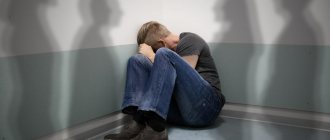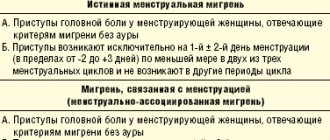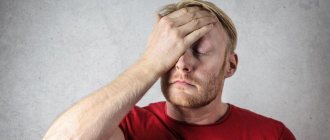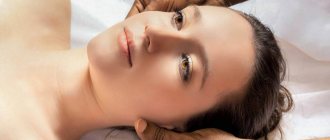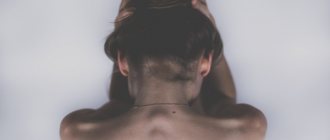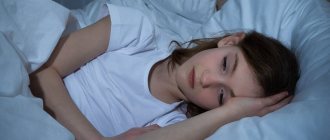Useful articles
Many people mistakenly believe that migraine is a disease of adults, but as practice shows, it occurs among children and adolescents. The difficulty lies in the fact that it can be quite difficult to diagnose migraine in adolescents in a timely manner and, accordingly, treat it adequately. In reality, this disease greatly worsens the child’s quality of life and causes him constant discomfort, both physical and psychological.
Causes
During adolescence, migraines can develop as a result of the following factors:
- lack of sleep;
- hormonal imbalance;
- menarche in girls;
- music too loud;
- overwork of the body, both physical and mental;
- stress;
- acclimatization to new conditions;
- spending long periods of time in front of a computer monitor;
- very bright light;
- poor nutrition;
- smoking;
- drinking alcohol;
- taking certain medications;
- long journey.
Causes of migraine in children
The causes of migraine in children are mental or physical fatigue, stress, excess or deficiency of body weight, high visual stress, changes in atmospheric pressure, sleep and nutritional disturbances (foods containing large amounts of tyramine - red wine, cheese and chocolate, etc.).
In teenage girls, migraines can develop due to premenstrual syndrome (PMS). Migraine in children can have more than 160 causes, but is always associated with provocateurs or triggers.
The causes of migraine in children can also be hereditary in nature and are associated with disorders of the nervous system and endocrine organs.
Migraine symptoms in teenagers
Migraines are often observed in those children who are determined, ambitious, and have an active lifestyle. Signs of migraine in a teenager that requires immediate treatment may include:
- splitting pain in the head, which can be localized in the temples, frontal lobe, eyes, one half of the skull;
- lack of strength;
- nausea;
- general weakness in the body;
- vomit.
The duration of the attack varies: from one hour to several days, which is why the teenager’s well-being suffers greatly. During periods of pain, the child takes his head with his hands and bends away from it. Usually, for migraines, simple analgesics do not give the expected effect.
Symptoms of migraine in children
The symptoms of migraine in children are practically no different from the symptoms of the disease in adults. Often, signs of migraine attacks that require professional intervention and treatment are observed at the ages of 7-9 and 11-12 years. This is due to significant loads, the volume of which increases due to the transition from kindergarten to school life. The transition from primary to secondary classes is also accompanied by changes in load volumes.
The first sign of a migraine is a throbbing attack of pain in a certain part of the head (left or right). Painful sensations first occur with a certain frequency and can last for 10-20 minutes, after which they fade away sharply. Gradually, the interval shortens, and the attacks of pain and the duration of the migraine increase. The pain may last for several hours or even days.
Depending on the symptoms that appear, there are several forms of development of the disease:
- Common migraine. It has no prerequisites before the start of a painful attack. Most often, a child may feel slight weakness a few minutes before the onset of a migraine. This form of the disease is characterized by the presence of nausea and vomiting. Drowsiness and lethargy may occur. Loss of consciousness or mild sound hallucinations are also symptoms of migraine in children. The difficulty is that it is simply impossible to predict the onset of an attack in order to give the necessary medicine. This is especially dangerous if migraine of this form appears in children aged 9-11 years.
- Classic shape. It is possible to recognize the symptoms of migraine in children. This allows you to take certain measures in advance and relieve pain even before the attack begins. A harbinger may be: a sharp impairment of hearing, vision or smell. The child may lose the sense of touch. Sudden dizziness, inattention, or disturbance in gait are also signs of an impending migraine attack.
It should be understood that all these signs of the disease can appear in a very young child (between the ages of two and five years). These symptoms of migraine in children require treatment, because if they are ignored, pathologies may develop.
When should you see a doctor?
Listen carefully to your child. If he begins to complain of headaches and other manifestations of this disease related to the symptoms described above, then you should think about the fact that your child’s health is at risk. At the first signs and symptoms, treatment for migraine in children should begin immediately. But which specialist should I contact?
If you are unsure of the diagnosis and doubt that your child is developing migraine, then it is worth making an appointment with a pediatrician or general practitioner in the Central Administrative District. If migraine is diagnosed, then further observation and treatment will be carried out by a neurologist, since it is this doctor who has the necessary specialization.
There are other specialists whose appointments may be recommended by your doctor as additional assistance. This:
- chiropractor;
- masseur;
- reflexologist.
Treatment of migraine in children, as well as other common and complex diseases diagnosed in children, is one of the areas of activity of the multidisciplinary medical center (Clinic of Academician Roitberg). The clinic is located in the center of Moscow (Mayakovskaya metro station).
Diagnosis and treatment of migraine in children
If you suspect that your child has migraines, be sure to consult a neurologist who can either confirm or refute the diagnosis. Note that diagnosis is carried out quite quickly. Sometimes it is enough for a specialist to examine the child and talk with him and his parents. In some cases, the doctor prescribes blood tests. Studies are being conducted of the vascular bed of the central nervous system, as well as the structure and function of the brain.
When the neurologist receives all the necessary data and determines the type and degree of development of the disease, then the most effective treatment for migraine in children will be prescribed. It is important to understand that there are specific approaches not only for various manifestations of the disease, but also at different ages of the child. But how are migraines treated for children?
Doctors are trying to choose the most optimal option, trying to prevent the occurrence of attacks. They take into account that taking medications is equally dangerous for both young children and adolescents. Medications can significantly affect a growing body. More often, when treating migraine in children, the choice is on preventive measures.
For these purposes, triggers that contribute to the development of the disease are identified. They should be completely excluded from the child's life. Painkillers may be prescribed. Drugs are selected individually. The doctor focuses on the needs of the child’s body. The main criterion is the safety of prescribed medications.
Prevention of migraine in children
How migraines are treated for children is already known. But what preventive measures should be taken to prevent the occurrence and development of this disease?
There are a lot of provoking factors. And the first thing that needs to be done is to eliminate their influence on the child.
To reduce your chances of developing a migraine attack as much as possible:
- it is necessary to create and follow a clear sleep schedule, which must exactly correspond to the child’s age;
- you need to choose the required amount of physical and sports activities, taking into account the characteristics of the child’s body. You should focus on the maximum capabilities of the baby. It is imperative to follow all doctor’s recommendations;
- It is worth limiting the consumption of certain foods. Pay attention to those foods and drinks, the excess of which in the diet has a bad effect on the health and well-being of the child;
- Regularly carry out wet cleaning in the rooms where the baby is. Don’t forget to ventilate the rooms of your apartment or house more often. A hot and stuffy atmosphere does a lot of harm and affects the development of migraines;
- it is necessary to reduce the level of stressful situations. Try to protect your child from aggression and other manifestations that affect the child’s psychological state. This applies to both the characteristics of relationships in the family and communication in society;
- control the noise level in your home. Carefully monitor the lighting fixtures in your living space (they should not be bright, and if they fail, which is manifested by blinking or flickering, immediately remove or replace the item);
- set a TV viewing schedule and limit the time your child can spend on gadgets (including tablets, smartphones, computers);
- Avoid using household chemicals and other products that have a strong and pungent odor.
All these measures will help to cope with the task.
There are several types of migraine in teenagers:
- with ophthalmoplegia, when the functioning of the eye muscles is disrupted (dilated pupils, blepharoptosis);
- simple - manifested by sharp or increasing pain, intensifies with movement, accompanied by abdominal pain, muscle tension, the desire to hide from the light source, vomiting;
- basilar – characterized by speech and coordination disorders, vomiting, blurred vision, dizziness (usually occurs in girls during puberty);
- with aura - this is a migraine, in which typical signs first appear (flashes of light, spots before the eyes, sensation of smells), and after them, after 30-60 minutes, an attack of pain begins;
- with hemiparesis - this migraine is accompanied by impaired motor and speech functions, muscle weakness, clumsiness, and there may be a visual aura.
Migraine in children symptoms
When a child has a headache, we don’t even assume that it could be a migraine.
In children, the symptoms are obligatory pain on one or both sides, nausea or even vomiting, photophobia, blurred vision and speech, blurred vision or flashing spots, dizziness, numbness in the limbs, goosebumps, etc. May occur with or without aura (precursors of migraine).
The aura can be visual and sensitive. For example, the sensation of flashes of light, sparkles, spots, or the feeling of goosebumps, numbness.
If your child has such manifestations, then it is most likely a migraine. In children, symptoms disappear after a few minutes or hours, and sometimes last for days.
Treatment of migraine in adolescents
This disease is quite difficult for adults, and even more so for children. It is important that parents are interested in the child’s treatment and are actively involved in the therapy process. This will help avoid such negative consequences of the disease for adolescents as: complexes, decreased performance and self-esteem, and self-isolation.
Important: Treatment of migraine in adolescents must begin at the first signs of the disease, and this should only be done under the supervision of a doctor! Specialists will not only select the necessary medications, but will also tell you in detail how to live with this disease, because it has a predominantly chronic course and requires patience and consistency in the activities carried out. During an attack, the child should take the prescribed pills, lie down, close the curtains in the room, open the window, apply a wet compress to the head or massage and try to sleep, since the migraine usually goes away after sleep. In your diet, you should limit the consumption of foods such as canned food, sausages, chocolate, sweets, etc., replacing them with fresh vegetables, fruits, lean meat and fish, milk, kefir, and yogurt. In some cases, acupuncture and working with a psychotherapist have a good effect. It is not uncommon for migraines to go away on their own after age 20, but this is not always the case. You need to learn to live with it and behave correctly during attacks in order to almost completely neutralize their impact on your general condition. The doctors at Alkoklinika will certainly help you with this.
The text was checked by expert doctors: Head of the socio-psychological service of the Alkoklinik MC, psychologist Yu.P. Baranova, L.A. Serova, a psychiatrist-narcologist.
CAN'T FIND THE ANSWER?
Consult a specialist
Or call: +7 (495) 798-30-80
Call! We work around the clock!
Treatment of migraine in children
Treating migraines in children is a very difficult task. First you need to understand what causes migraine, treatment should be prescribed only after that. Therapy will be successful if:
- Correct and, most importantly, timely diagnosis will be carried out.
- The approach to each case will be individual.
- The use of medicinal and non-pharmacological methods should be done in a comprehensive manner.
- Treat migraines for a sufficient period of time.
- Lead a healthy lifestyle.
Doctors will prescribe the necessary medications, and parents should: establish a routine for the child, ensure proper sleep and nutrition, and regular and dosed exercise. This is exactly what modern children need so that they are not worried about the illnesses of adults.
Clinical Brain Institute Rating: 5/5 — 1 votes
Share article on social networks
